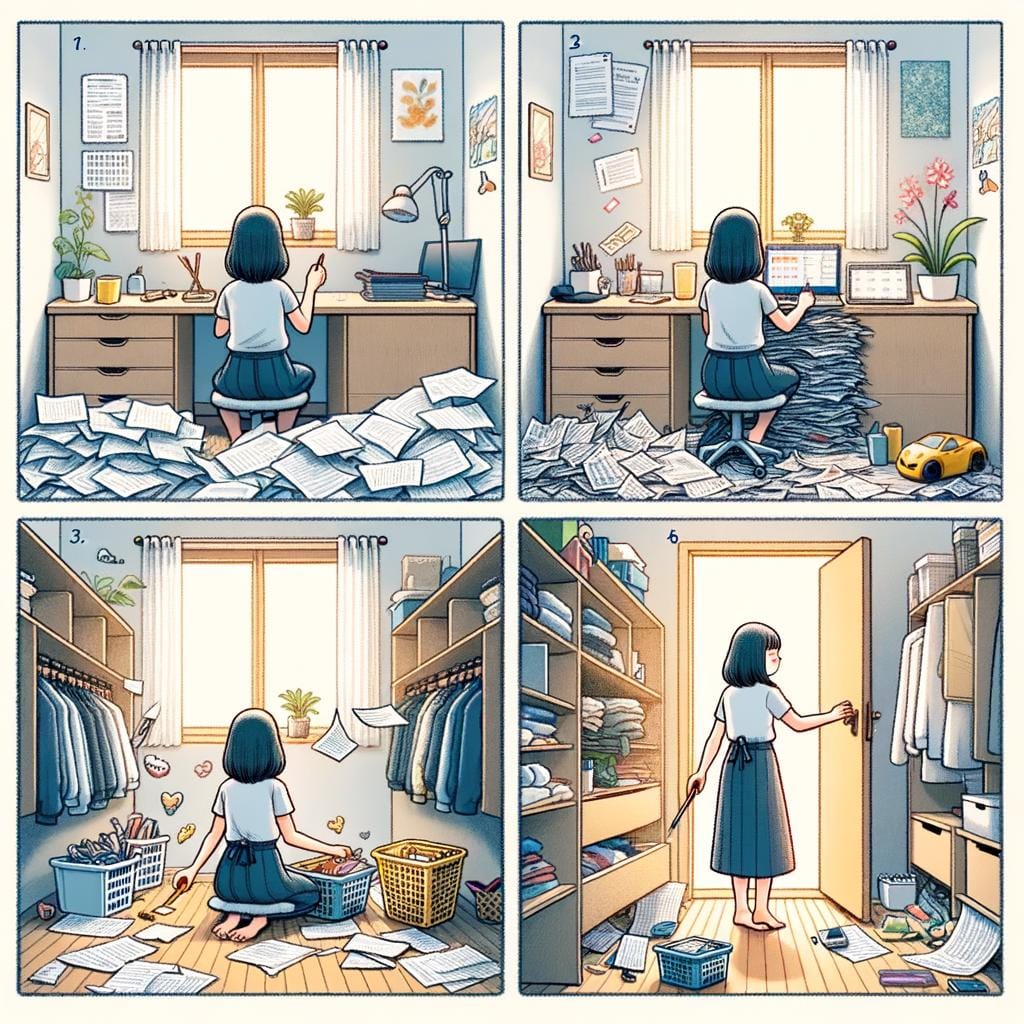In today’s fast-paced world, families often find themselves overwhelmed with clutter in their homes. Implementing decluttering strategies for families is crucial to creating a space that promotes reduced stress, increased productivity, and improved mental well-being. By taking the time to declutter and organize your living spaces, you can create a more peaceful environment for you and your loved ones.
Not only does decluttering help in reducing stress levels by providing a clean and organized space, but it also allows for improved productivity as there are fewer distractions and obstacles in your way. A clutter-free home can help clear the mind and focus on tasks at hand, whether it be work or spending quality time with family members. Additionally, an organized living space can contribute to better mental well-being by creating a sense of calm and tranquility.
To kickstart the decluttering process, setting goals and creating a plan of action is essential. Motivating yourself and your family to begin decluttering can be achieved by breaking down the tasks into manageable sections like tackling the living room clutter, organizing the kitchen space, decluttering bedrooms, managing paper clutter, creating storage solutions, and establishing maintenance habits. These steps will not only lead to a clutter-free home but also foster a harmonious atmosphere conducive to personal growth and family bonding.
Getting Started
Setting Goals
The first step in the decluttering process for families is setting clear and achievable goals. Sit down with your family members and discuss what areas of the home need decluttering the most. Identify specific items or spaces that are causing the most stress or disorganization. By setting goals together, you can create a sense of shared responsibility and motivation to tackle the clutter as a team.
Creating a Plan of Action
Once you have established your decluttering goals, it’s essential to create a detailed plan of action. Break down the decluttering process into manageable tasks that can be completed within a set timeframe. Designate specific days or times for decluttering sessions to ensure that everyone in the family is on board and committed to the process. Consider assigning tasks based on each family member’s strengths and preferences to make the process more efficient and enjoyable.
Implementing Decluttering Strategies
To effectively declutter as a family, consider implementing proven strategies such as the “Four-Box Method” (keep, donate, trash, relocate) or the “KonMari Method” (tidying by category). Encourage open communication between family members about which items hold sentimental value and which can be let go of.
Remember that decluttering is not just about getting rid of stuff; it’s also about creating an organized and peaceful living environment for everyone to enjoy. By working together and following these decluttering strategies for families, you can transform your home into a clutter-free sanctuary where everyone can thrive.
Decluttering the Living Room
Organizing Toys
One of the biggest challenges in decluttering a family living room is dealing with toy clutter. A great strategy for managing toys is to minimize the number of toys available at a given time. Consider rotating toys, keeping some out while others are stored away.
This not only reduces visual clutter but also helps keep kids engaged and interested in their toys since they’re not overwhelmed by too many choices. Additionally, incorporating storage solutions such as bins, baskets, toy chests, and shelves can help keep toys organized and easily accessible when needed.
Managing Books
Books are another common source of clutter in family living rooms. Start by going through your book collection and keeping only what you truly love or plan to read again. Consider donating books that no longer spark joy or interest.
To organize books efficiently, categorize them by genre, author, or size and use bookshelves or floating shelves to display them neatly. You can also incorporate decorative baskets or magazine racks to store magazines or small books for easy access and a clutter-free look.
Dealing With Electronic Devices
Electronic devices like remotes, gaming consoles, chargers, and cords often add to the chaos in the living room. Establish designated charging stations for devices to keep cords organized and prevent them from getting tangled. Invest in cable organizers or cord holders to manage wire clutter effectively.
Consider using remote control caddies or trays to store remotes in one central location for quick access when needed. Decluttering electronic devices not only enhances the aesthetic appeal of the living room but also makes it easier to locate items when required.
Organizing the Kitchen
The kitchen is often considered the heart of a home, where families gather to prepare meals and create memories. However, it can also quickly become a hotspot for clutter with various utensils, pantry items, and appliances taking up space. Implementing decluttering strategies for families in the kitchen not only creates a more functional and efficient area but also promotes a sense of calm and organization in this bustling space.
One effective way to start decluttering the kitchen is by going through each category of items present – utensils, pantry items, and appliances – and assessing their use and necessity. Keeping only those items that are regularly used or serve a specific purpose can significantly reduce the amount of clutter in your kitchen. Consider donating or selling items that are duplicate or no longer needed to further streamline your kitchen space.
Another decluttering strategy for families in the kitchen is to organize storage areas effectively. Utilize drawer dividers, storage containers, and cabinet organizers to keep utensils, pantry items, and appliances neatly arranged. This not only enhances the functionality of your kitchen but also makes it easier to locate items when cooking or meal prepping. Additionally, labeling containers or shelves can help family members maintain the organization over time.
Ensuring that every item has its designated place in the kitchen goes a long way in maintaining a clutter-free environment. By involving all family members in the decluttering process and establishing organizing habits like cleaning up after each meal or reorganizing once a week, you can create a harmonious and efficient kitchen space for everyone to enjoy. Making these small changes can have a significant impact on reducing stress levels and improving overall well-being within your household.
| Decluttering Strategy | Benefits |
|---|---|
| Assessing item necessity | Reduces clutter |
| Effective storage organization | Enhances functionality |
| Involving family members | Promotes harmony |
Decluttering the Bedrooms
Decluttering and organizing bedrooms is essential for creating a peaceful and functional space within a family home. Bedrooms often accumulate clutter in the form of unused clothes, shoes, accessories, and other personal items. By implementing effective decluttering strategies for families in these spaces, you can create a calming environment that promotes relaxation and better sleep.
One helpful strategy for decluttering bedrooms is to start by sorting through clothing items. It’s important to go through every piece of clothing and decide whether to keep, donate, or discard them. Encourage family members to be honest about what they actually wear and what has been sitting untouched for months. Consider implementing a “one in, one out” rule to prevent excessive clothing accumulation in the future.
Another key aspect of decluttering bedrooms is organizing storage areas such as closets and drawers. Invest in storage solutions like bins, baskets, or drawer dividers to maximize space and keep items neatly arranged. Consider rotating seasonal clothing to make it easier to access what is currently in use. Creating designated spaces for different categories of items will not only declutter the bedroom but also make it easier to maintain organization in the long run.
Lastly, involve the whole family in the decluttering process to encourage collaboration and shared responsibility for maintaining tidy bedrooms. Schedule regular cleanouts or organizing sessions to prevent clutter from building up again. By working together on decluttering and organizing bedrooms, families can create harmonious living spaces that promote peace and relaxation.
| Benefits of Decluttering Bedrooms | Effective Strategies |
|---|---|
| Creates a peaceful environment conducive to relaxation | Sorting through clothing items thoroughly |
| Promotes better sleep by removing visual clutter | Organizing storage areas with bins, baskets, or dividers |
| Encourages shared responsibility among family members | Involving the whole family in regular cleanouts or organizing sessions |
Managing Paper Clutter
As families go about their daily lives, one common source of clutter that can quickly pile up is paper. From school notices to bills and everything in between, paper clutter can easily overwhelm a household if not managed properly. Implementing effective decluttering strategies for families specifically targeted towards managing paper clutter is essential in maintaining a tidy and organized home environment.
Here are some techniques for dealing with paperwork, mail, and other paper clutter that tends to accumulate in family homes:
- Designate a specific area for incoming mail: Create a designated spot, such as a basket or tray near the entrance of your home, where all incoming mail can be placed. Sort through it regularly to prevent papers from piling up.
- Invest in a filing system: Set up a filing system with different categories for important documents, such as medical records, financial statements, and school information. Use labeled folders or binders to keep everything organized and easily accessible.
- Go digital whenever possible: Consider switching to electronic statements for bills and subscriptions to reduce the amount of physical paper entering your home. Scan important documents and store them digitally to free up physical space.
By implementing these decluttering strategies for managing paper clutter within your family home, you can effectively reduce the amount of unnecessary paperwork taking up valuable space and create a more streamlined and organized living environment for everyone. Remember that consistency is key when it comes to maintaining a clutter-free home, so make sure to incorporate these techniques into your regular routine.
Creating Storage Solutions
When it comes to decluttering strategies for families, creating efficient storage solutions is key to maintaining an organized home. By utilizing baskets, shelves, and other organizational tools, you can maximize storage space and keep your family’s belongings tidy and easily accessible. Here are some ideas to help you make the most out of your storage areas:
1. Baskets: Baskets are not only functional but also add a decorative touch to any room. Use baskets to store toys in the living room, towels in the bathroom, or shoes near the entrance. Opt for different sizes and shapes to fit various items and keep them organized.
2. Shelves: Installing shelves on walls can create additional storage space without taking up floor space. In the kitchen, consider adding open shelving to display dishes or cookbooks. In bedrooms, use shelves to store books, photo frames, or decorative items. Make sure to secure heavy items properly for safety.
3. Other Organizational Tools: There are numerous organizational tools available that can help declutter and streamline your home. From closet organizers and drawer dividers to under-bed storage containers and hanging shoe racks, there are options for every area of your house.
By incorporating these storage solutions into your decluttering process, you can create a more organized and functional living environment for your family. Whether it’s maximizing space in a small apartment or keeping a large house tidy, utilizing baskets, shelves, and other organizational tools can make a significant difference in maintaining order and reducing stress in your everyday life.
Establishing Maintenance Habits
In the quest for a clutter-free and organized home, establishing maintenance habits is crucial. By developing daily or weekly routines, families can ensure that their living spaces remain tidy and free of excess belongings. These habits not only help in maintaining a neat environment but also prevent future accumulation of clutter. Consistency is key to ensuring long-lasting results from your decluttering efforts.
One effective strategy for maintaining a clutter-free home is to designate specific tasks for each day of the week. For example, Mondays could be dedicated to organizing paperwork, while Fridays can be reserved for decluttering and organizing common areas like the living room or kitchen. By breaking down tasks into manageable chunks and spreading them out throughout the week, families can prevent overwhelm and stay on top of their organization efforts.
Additionally, involve every family member in the maintenance routines to promote accountability and shared responsibility. Encourage children to put away toys after playing, have everyone pitch in with meal cleanup in the kitchen, and make it a team effort to keep bedrooms organized. By fostering a culture of tidiness within the family unit, everyone learns the value of organization and takes pride in contributing to a clutter-free home.
Remember, consistency is key when it comes to maintaining an organized space, so stick to your routines and celebrate small victories along the way. With dedication and commitment, you’ll establish habits that will keep your family’s home clutter-free for years to come.
Frequently Asked Questions
What Is the Rule of 5 Decluttering?
The Rule of 5 decluttering involves choosing five items to either throw away, donate, or sell every day. This method helps to gradually declutter spaces without feeling overwhelmed by the process.
What Is the 20 20 20 Rule for Decluttering?
The 20-20-20 rule for decluttering suggests spending 20 minutes each day organizing a specific area, getting rid of 20 items you no longer need, and putting away 20 things that are out of place. This consistent approach can lead to significant decluttering progress over time.
What Is the Core 4 Method of Decluttering?
The Core 4 method of decluttering focuses on four main areas: trash, give away/sell, put away, and keep. By sorting items into these categories when decluttering a space, it becomes easier to make decisions about what stays and what goes based on priorities and usefulness in everyday life.

Hello, I’m April Denton, your go-to expert for all things home decluttering and organization. With over a decade of experience helping individuals transform their living spaces into serene, clutter-free sanctuaries, I am passionate about the life-changing benefits of decluttering. My journey into the world of organization began out of necessity, juggling a busy career and a bustling household. I quickly realized that a well-organized home was the key to a more balanced, stress-free life.





